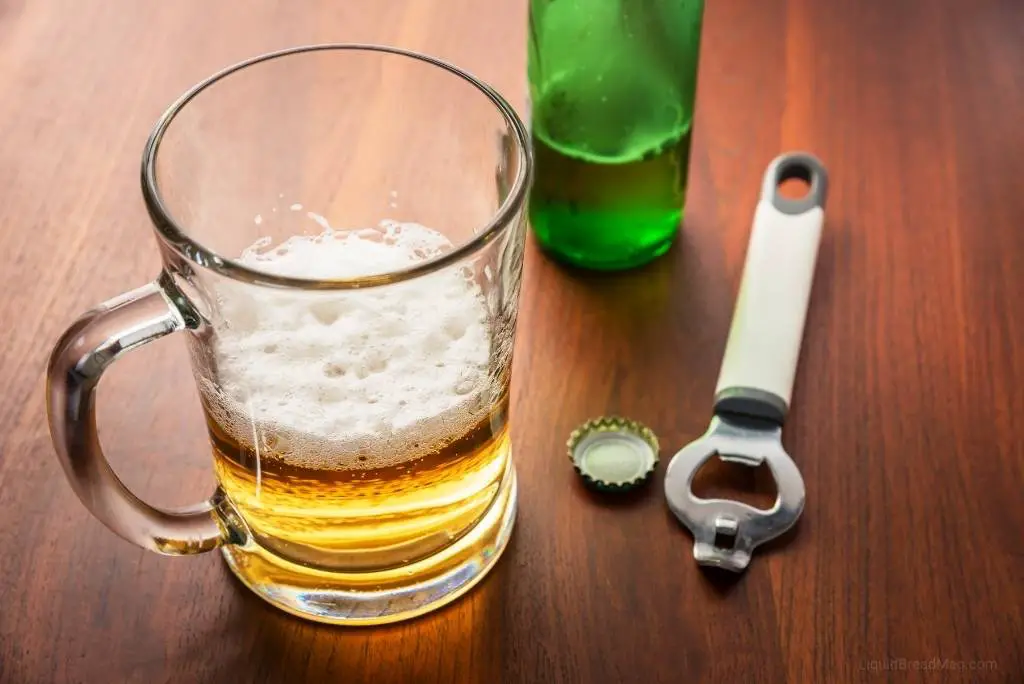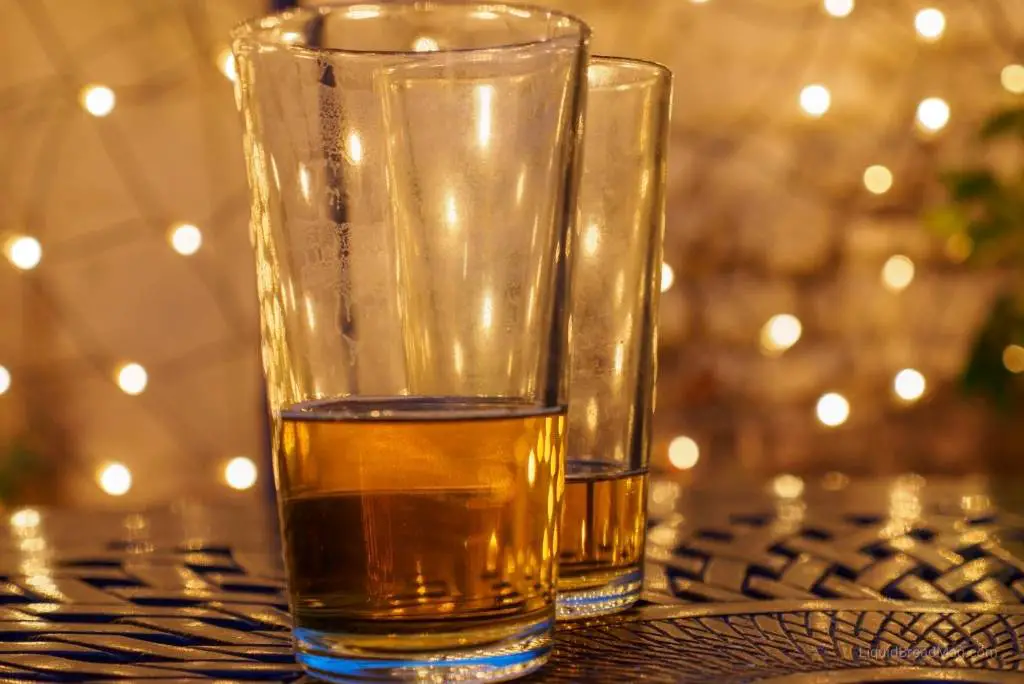There’s nothing like coming home from a long day and kicking back to sip a cold beer. In fact, a 2019 article in Time Magazine calls beer “The World’s Most Celebrated Drink.” Suppliers go through a lot of work to preserve this golden nectar, and part of the process includes properly bottling the beer to reduce alcohol evaporation.
The alcohol in an open standard beer bottle can evaporate as fast as 2.5% every hour at room temperature (68 to 77°F or 20 to 25°C). Keep in mind that this calculation assumes a large surface area of alcohol is in contact with the air.
Alcohol, in general, has a faster evaporation rate than water, and this evaporation rate is why beer starts to taste funny after a couple of days of sitting out (in addition to no longer having any carbonation).
However, the speed at which beer as a whole evaporates is challenging to determine, and there are many factors that can influence this process. Read on to explore some of these factors.

BEER DROP: Boxes of beer from Award-winning microbreweries → Join The Club
Understanding Why Beer Evaporates
You may wonder why your beer is evaporating, especially if it’s stored at room temperature and not in a very hot space. To understand this, you’ll have to understand evaporation in greater detail.
Evaporation Is a Change in Physical State
Evaporation takes place when liquids turn to gas, and every liquid is capable of going through this change. Evaporation happens because molecules in liquid begin to move faster. As the molecules move faster, they develop more space between them and start to escape as gas.
Every liquid requires a different amount of energy to get the molecules moving. This energy amount is called the “heat of vaporization.” By increasing the amount of energy (heat) put into a liquid, you can turn any liquid into a gas.
Beer Is a Combination of Water and Alcohol
Why beer evaporates has everything to do with how it’s made.
There are four main ingredients that make up beer:
- Water
- Malt (grain)
- Hops
- Yeast
The yeast helps the grain go through the fermentation process and produce alcohol. Hops add flavor and fullness to the beer.
The amount of water and alcohol differs between brews. Beer craftsmen will alter the levels of water and alcohol in order to influence the taste and potency of the final product. The different tastes and aromas also come from variations of the four main ingredients.
That said, despite the addition of yeast and hops, beer is, essentially, ethyl alcohol suspended in water. Alcohol and water are both liquids and can, therefore, undergo evaporation – which means that beer can evaporate as well.
Evaporation Speed of Water vs. Alcohol
Water and alcohol have different boiling points. That means that they begin turning to gas at different times. Regular tap water has a boiling point of 212°F (100°C) while ethyl alcohol boils at about 173°F (78.3°C).

As beer warms up, the alcohol begins to evaporate well before water does. This difference is why the taste of your drink may go from rich and full to basically barley water after a few days. Alcohol escapes into the air, leaving behind water and added flavors.
Factors That Influence the Speed of Evaporation
There are several factors that influence the speed of evaporation. A few of these variables include temperature, alcohol content, and the surface area exposed to air. If you want to change your evaporation rate, you will need to alter one of these factors.
Colder Means Slower
Temperature is one of the primary influences on evaporation. The warmer a liquid is, the more volatile its molecules are. The more volatile the molecules, the more quickly they escape the liquid. Alcohol molecules usually are more volatile than water, and this volatility is the reason behind alcohol’s fast evaporation.
Water molecules can become very volatile at higher temperatures. At these higher temperatures, both alcohol and water molecules will start evaporating at high rates.
So, at higher temperatures, you’ll lose your beer to the environment twice as fast. You may also discover that your drink tastes even less appetizing. If you want to keep the alcohol and water in your beer balanced, keep your beer cool.
Higher Proofs Go Faster
Beer with higher proofs of alcohol will evaporate faster at room temperature. Proof measures the percentage of alcohol content in a beverage.
To calculate proof, you multiply the percentage of alcohol content in the drink by two. The resulting answer is your proof.
Let’s say your tasty adult drink contains 20% alcohol and 80% water. 20 x 2 = 40. So your drink would be “40” proof alcohol.
The higher the amount of alcohol, the more alcohol molecules will be evaporating. Since alcohol has a higher evaporation rate, drinks with a greater proof will evaporate faster than those with a lower proof.
Air Contact Increases Evaporation
The rate of evaporation will also increase based on air contact. The more surface area of the beer that comes in contact with the air, the more the evaporation rate will increase. This is because more molecules come in contact with the air, which allows them to escape faster.
As high-energy water and alcohol molecules come in contact with the air, they bind and escape. Generally, these molecules saturate the air directly over the bottle of beer, slowing evaporation. Water and alcohol molecules looking to escape cannot bind to the same air molecules.
If it is a windy day, evaporation would be faster. The wind would constantly blow the hovering molecules away. The new air molecules would then be available for binding. The process would then begin to slow as fewer molecules come in contact with “fresh” air.
The Bonus Factor: Air Pressure
Although not always acknowledged, air pressure can also influence evaporation. Liquids in containers at higher altitudes evaporate faster due to the lower pressure outside the container. Molecules are always looking for ways to move from areas of high pressure to low pressure.
To illustrate, think about a normal bottle of champagne. If you shake the bottle, you generate energy. That energy speeds up the molecules, generating gas as liquid is evaporated. The gas then increases the pressure inside the bottle as the molecules bounce around, looking for a lower pressure area.
When you pop the cork, the pressure is released, and the gas escapes to the lower pressure environment outside the bottle. This is why you can sometimes see steam leave the bottle opening.
Something similar happens for beer opened in areas that have low air pressure. As the beer gains altitude and the air pressure outside drops, the molecules in the bottle seek to escape to the lower pressure environment, generating energy. This energy evaporates some of the liquid, generating gas.
The pursuit of lower pressure environments is why containers of liquid may swell on airplanes as liquid is evaporated, the pressure inside the container builds, and the molecules fight to burst free.
Final Thought: Keep Your Beer Safe
The rate of beer evaporation differs on several factors, including the type of beer and the alcohol content. Higher proofs in warm temperatures evaporate fastest. Lower proofs in cold temperatures evaporate slowest. Humidity and low-pressure can also increase evaporation.
To preserve your beer, keep it closed until you’re ready to drink it or store in an airtight container, and minimize contact with heat and air. If you do open it and decide not to finish it, slip it in the refrigerator to keep it fresh. The longer you leave it out in warm temperatures, the faster it will evaporate.
